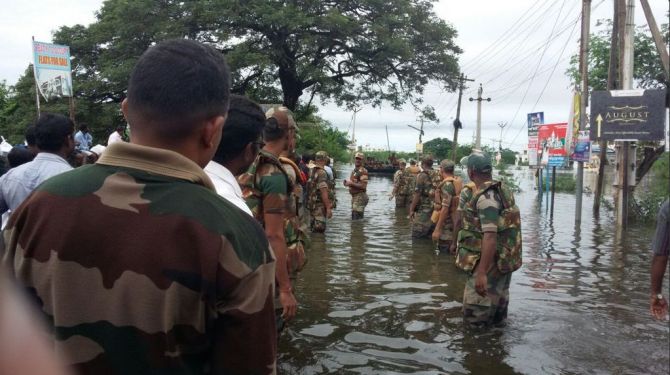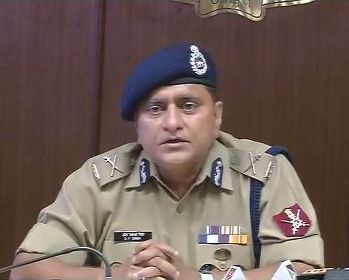
'Coordination between our 50 teams, each with a strength of 45 men, played a key role in rescuing flood-affected people in Chennai. In all, we succeeded in rescuing over 20,000 people.'
'The NDRF, an exclusive dedicated standalone multi-disciplinary disaster response force, is the only one of its kind in the world.'
NDRF chief O P Singh on how his organisation helped rescue and relief in flood-ravaged Chennai.
National Disaster Response Force Director General O P Singh refuses to be drawn into any controversy regarding the unprecedented release of over 29,000 cusecs of water from the Chembarambakkam reservoir on the night of December 1, without having alerting the state government, the police or the power utility services.
Water experts believe this release was the main reason for the floods that devastated Chennai with the situation being made worse by the heavy rainfall.
Singh, below, left, is a 1983 cadre Indian Police Service officer. As head of the NDRF he was responsible for the rescue of nearly 50,000 civilians during the disastrous flooding of Sringar in September last year. His organisation's work during the Nepal earthquake earlier this year was much appreciated by the governments of Nepal and India. The NDRF was formed by an Act of Parliament in September 2014.
He spoke exclusively to Rashme Sehgal for Rediff.com
You had 50 NDRF teams working night and day to rescue people through this crisis. What has the NDRF learning curve been from this?
What we witnessed in Chennai is the phenomenon of urban flooding. It is very different from rural floods or floods in semi-urban areas. Its special feature is that as water levels start to rise, the water begins to flow in a very swift manner. This kind of urban flooding we are witness to can be described as a very recent phenomena.
We witnessed it in Mumbai ten years ago. Jammu and Kashmir was our first experience of intense urban flooding.
How did you go about tackling the situation in flood-hit Chennai?
We are the only official disaster response team in the country. We have a strength of 12 batallions of 15,000 men drawn from the Central Reserve Police Force, the Indo-Tibetan Border Police, the Border Security Force and the Central Industrial Security Force who join us for a period of deputation lasting five years.
The first two years are spent providing them very intensive and highly professional training in how to handle disaster situations in different areas, whether it be the collapse of structures, search and rescue, deep underwater diving, underwater communication, medical first responder and also how to deal with biological, radiological and nuclear emergencies.
Coordination between our 50 teams, each with a strength of 45 men, played a key role in rescuing the flood-affected people in Chennai.
In all, we succeeded in rescuing over 20,000 people.
 If you spend two years training them, then why should they revert back to their earlier cadre three years later? Doesn't all this intensive training go waste by this kind of reversion?
If you spend two years training them, then why should they revert back to their earlier cadre three years later? Doesn't all this intensive training go waste by this kind of reversion?
That is a very valid question. If you permanently keep them (in the NDRF) then they might lose their motivation. We are thinking of keeping them for a longer period and are considering the possibility of extending their deputation from five to ten years.
We are also looking at a possibility of allowing 12 per cent of our force to be kept in the NDRF on a permanent basis.
You need to remember that this is an exclusive dedicated standalone multi-disciplinary disaster response force. It is the only one of its kind in the world. They focus only on disasters and nothing else.
When there are no disasters, we spend our time trying to empower the community because the community is the first responder to a disaster. We also interact closely with the police, the fire brigade and also provide training to organisations like the NCC (National Cadet Corps), the National Service Scheme and the home guards. We are capable of reaching a disaster within 20 minutes.
Were you able to reach Chennai within 20 minutes of the flood occurring?
In Chennai, our 50 teams flew in from Bhatinda, Guwahati, Patna and Pune. We had already pre-positioned some teams around Chennai and were receiving regular reports from the Indian Meteorological Department.
You had pre-positioned your teams around Chennai prior to the massive flooding?
We had four teams that had been pre-positioned. We had teams in Cuddalore and Kanchipuram and had two teams in Puducherry. Within two to three hours of being informed about the heavy rainfall and about the release of water from the reservoir, our local battalion stationed in Ernakulam was there.
What were the immediate steps you took?
Our first steps were on how to evacuate the people who were marooned. We had to put them in boats and take them to a safer location. For that we needed divers, life jackets and boats.
In some areas there was eight to nine feet of water. Chennai airport was submerged in eight to nine feet of water. Several localities were completely submerged.
The second major problem we faced was the breakdown of power resulting in a major communication failure. People's mobile phones had gone dead. There was also the apprehension was of people getting electrocuted.
The other problem we faced that even though people were marooned, they were not willing to leave their homes.
Why was that? Did people feel that in their absence, their homes would get looted?
People living in ground floor houses agreed to get evacuated, but those living on the first floor moved to the second floor and then onto the roof.
The settlements along the banks of the river Adyar which were all low lying areas, saw huge amounts of water collect there. Our teams found it very difficult to navigate these areas.
More than 300 people died in these floods.
A large number of these deaths took place in some hospitals because of the power failure. The ICU units in the hospitals were affected because of the lack of power.
Our 50 teams were using Quick Deployable Antennae (for satellite communications) which is a portable system and can be used both in the digital and analogue mode. But this QDA is an internal system that can be used only by us.
But on our helpline, we were getting information via SMS, e-mails and Whatsapp, and also from television channels. I was stationed in Chennai and constantly telling my response team to reach the area from where the alert had been sounded. I was acting as a link between the victim and the parent or others.
Obviously, during the flood, people were on edge, they had become nervous and very jittery. I had to keep assuring the public. It was a huge challenge to communicate and reach out to the people especially since the power facilities were down.
But our men were working round the clock. I would like to cite the example of one rescue mission that my men undertook of a woman called Deepthi who was in her final stages of pregnancy and living in the Ramapuram area. Two NDRF sub-inspectors Bijumon and Satish reached out to her in a boat, but could not load her onto a boat.
She had to finally be rescued by a chopper. The two jawans helped her climb onto a water tank from where they helped her climb her onto an IAF helicopter being flown by a team led by Wing Commander Simon and Squadron Leader Venkatraman.
The lady gave birth the next day to two twin girls and her father Mohan Raj sent me a letter commending the work done by the NDRF and hoping his twin grand-daughters would join the NDRF one day.
The NDRF received praise in Chennai, but the NDRF received criticism for its rescue operation work during the floods that hit Kashmir last year.
No, I don't think so. The terrain of Srinagar is completely different from the terrain of Chennai. Srinagar is an extremely mountainous area. The Jhelum river had spilled over and mixed with the Dal Lake and the entire area looked like a vast sea.
The current there was very sharp and we had to use choppers. The flood water ended up dividing the old Srinagar city from the Dal Lake area. Our teams ended up rescuing 50,000 people in the operation.
Chennai used to be a dry city. But the incessant rain, unregulated construction and the release of a huge amount of water from the Chembarambakkam reservoir caused this deluge.
To go back to my earlier question, what is your learning from this deluge?
I believe we have to strengthen our response measures to meet disasters. But the long-term strategies would be to pay much greater attention to prevention and mitigation strategies. These will involve flood mapping and satellite imagery. But most important, we need to pay much greater attention to regulate development in our cities.
To take the example of Chennai, which as a city can be divided into three parts. No new construction must be allowed in the vulnerable parts of the city. The state government must take strong measures in this. I believe after witnessing two major floods that all urban construction must be regulated.
In terms of mitigation strategies, we need to construct water channels to drain out the water. More important, we need to revive the water channels that have been destroyed. We need to take very strong steps on this score.
Cities must develop resilience to face heavy rain and for that we need to take institutional measures to ensure that there can be no encroachment on marshlands, our traditional tanks and lakes that have shrunk must be restored and all the waterways that had been constructed to drain excess water must also be restored to ward off future threats.










